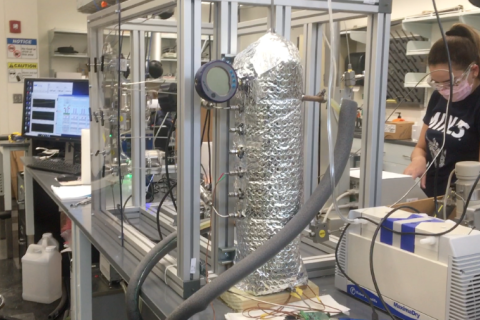Over the last few years, it has been clear that the electric power market is extremely close to using all available natural gas supply during the height of summer demand. During peak demand days, gas prices at the citygate have soared into new territory and a few areas have suffered brownouts. Several major lawsuits erupted between suppliers, marketers and municipalities that were on the short end of the stick in summer 1998 and 1999. One reason is that additions of new power capacity have dropped fairly steadily during the last 15 years, but power companies are now beginning to reverse that trend. Indeed, during the next 12 months, some 27,000 megawatts of natural-gas-fired capacity are planned to be added to the U.S. power system, says analyst Marshall Adkins of Raymond James & Associates in Houston. This should translate into gas consumption rising by 1.5 billion cubic feet per day, during those hottest summer days when gas-fired peaking units are running at full capacity 24 hours a day to meet air conditioning demand. This represents about a 2.5% increase in daily gas use, if one assumes average yearly consumption of 60 billion cubic feet per day. Power companies may ramp up their gas-fired generating capacity, but is there enough gas supply to fuel those new plants? The problem is that U.S. gas production was relatively flat in 1997 and 1998, as the U.S. gas rig count fell to the low 600 range, and production fell in 1999, when the rig count fell to 450. That has affected gas storage. What's more, it looks like there may not be enough gas available for demand this summer. "If we look at year-to-year gas storage differentials, [Minerals Management Service offshore and federal lease] production data or even state production date, all three sources suggest a year-to-year production decline of 4% to 6% in late 1999," Adkins says. While the rig count has steadily crept upward from its disastrous lows in 1999, "we do not believe that meaningful U.S. gas production increases will be seen until late 2000, [after the summer air conditioning season]," Adkins says in a recent report. He thinks the U.S. gas rig count needs to be around 675 in order to make gas production begin increasing. However, that number has not been yet reached. In February, the U.S. gas rig count was averaging around 620, versus about 450 the prior year. "On a summer-to-summer basis, gas production in the summer of 2000 should be down approximately 1 billion cubic feet, or 2% below the average seen in the summer of 1999." This shortfall gives Adkins confidence in his forecast of $3 per thousand cubic feet for 2000. -Leslie Haines
Recommended Reading
Going with the Flow: Universities, Operators Team on Flow Assurance Research
2024-03-05 - From Icy Waterfloods to Gas Lift Slugs, operators and researchers at Texas Tech University and the Colorado School of Mines are finding ways to optimize flow assurance, reduce costs and improve wells.
AI Poised to Break Out of its Oilfield Niche
2024-04-11 - At the AI in Oil & Gas Conference in Houston, experts talked up the benefits artificial intelligence can provide to the downstream, midstream and upstream sectors, while assuring the audience humans will still run the show.
Subsea Tieback Round-Up, 2026 and Beyond
2024-02-13 - The second in a two-part series, this report on subsea tiebacks looks at some of the projects around the world scheduled to come online in 2026 or later.
2023-2025 Subsea Tieback Round-Up
2024-02-06 - Here's a look at subsea tieback projects across the globe. The first in a two-part series, this report highlights some of the subsea tiebacks scheduled to be online by 2025.
Betting on the Future: Chevron Technology Ventures’ Investment Strategy
2024-04-09 - After a quarter century, Chevron Technology Ventures seeks both incremental and breakthrough technologies with its early-stage investment program.





